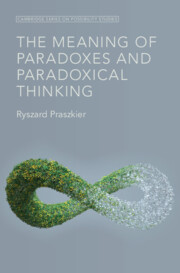Book contents
- The Meaning of Paradoxes and Paradoxical Thinking
- Cambridge series on possibility studies
- The Meaning of Paradoxes and Paradoxical Thinking
- Copyright page
- Contents
- Figures
- Tables
- Acknowledgments
- Introduction
- Part 1 Paradoxes and What They Do to Us
- Part II Sudden Unexpected Changes
- Part III Challenging the Impossible
- Part IV Peace and Its Challenges
- Part V Paradoxes and Creativity
- Part VI Paradoxes in Action
- Introduction
- Chapter 15 Turning the Impossible into the Possible
- Chapter 16 Paradoxes in Psychotherapy
- Chapter 17 Life and Paradoxes
- Discussion and Summary
- Chapter 18 Précis
- References
- Index
Chapter 16 - Paradoxes in Psychotherapy
from Part VI - Paradoxes in Action
Published online by Cambridge University Press: 04 April 2025
- The Meaning of Paradoxes and Paradoxical Thinking
- Cambridge series on possibility studies
- The Meaning of Paradoxes and Paradoxical Thinking
- Copyright page
- Contents
- Figures
- Tables
- Acknowledgments
- Introduction
- Part 1 Paradoxes and What They Do to Us
- Part II Sudden Unexpected Changes
- Part III Challenging the Impossible
- Part IV Peace and Its Challenges
- Part V Paradoxes and Creativity
- Part VI Paradoxes in Action
- Introduction
- Chapter 15 Turning the Impossible into the Possible
- Chapter 16 Paradoxes in Psychotherapy
- Chapter 17 Life and Paradoxes
- Discussion and Summary
- Chapter 18 Précis
- References
- Index
Summary
Psychotherapy can be seen as a specific and intensive learning context, and as such, is related to neural plasticity. Psychological techniques stimulate neurogenesis and increased synaptic plasticity. Sigmund Freud, the founder of psychoanalysis, initially developed the concept of the “contact barrier” and, hence, neuroplasticity. Research demonstrates that successful psychotherapy is indeed correlated with changes in brain activity and connectivity. Cognitive behavioral therapy and other psychotherapies alter consciousness in important and lasting ways. Measuring the effects of CBT for psychotic patients indicated that the rearrangement occurring at the neural level following psychotherapy may be a predictor for the subsequent recovery path of people with psychosis. The concept of paradox psychology was likely developed by the psychotherapists of the 1960s and 1970s. Paradox psychology may be applied in various ways, such as paradoxical interventions, Gestalt paradoxical practice, and paradoxical intensions. Examples of paradoxical interventions are provided, as well as paradoxical intensions. The Gestalt theory of change is presented, as well as the hypothesis that paradoxes induce neuroplasticity and openness to novel perspectives, possibly by developing some distance from one’s own problems, enabling an outside-the-box point of view. Paradoxes create a distance that induces a more creative approach, especially to one’s own problems.
Keywords
- Type
- Chapter
- Information
- The Meaning of Paradoxes and Paradoxical Thinking , pp. 129 - 137Publisher: Cambridge University PressPrint publication year: 2025

